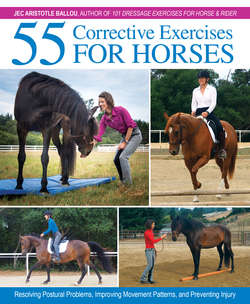Читать книгу 55 Corrective Exercises for Horses - Jec Aristotle Ballou - Страница 22
На сайте Литреса книга снята с продажи.
EXERCISE 8: Backing Down a Hill
Оглавление| PURPOSE: | Improves stability of the hindquarter joints. |
While the basic mechanics may seem similar, backing down rather than up a hill targets different muscle systems. Most importantly, it improves stability of the horse’s hindquarter joints—hip, stifle, hock. They must keep from wobbling while being in an extended position. Of the larger locomotion muscles, this exercise targets the extensor chain. It is contraindicated in the presence of sacral ligament injuries.
1 Locate a gentle slope as described in Exercise 7 (see p. 23).
2 Begin at the top of the hill and slowly ask your horse to walk backward in a very straight line to the bottom of the slope (fig. 1.10 A).1.10 A: Siobhan is careful not to rush Star backward. You can see that Star is not taking an equal length of stride with her front and hind legs, which we want her to learn to do.
3 Be sure to keep his steps measured so that each is the same length. To catch their balance, many horses will take a larger step with one of their forelegs compared to the other. This creates imbalance (fig. 1.10 B).1.10 B: Star’s posture improves in the second photo but Siobhan has to work to keep her moving in a straight line.
4 As with previous backing-up exercises, keep the horse in a correct topline posture throughout.
I always begin this exercise from the ground without a rider until the horse is rhythmic and balanced. There is quite a difference in just “getting through” the exercise versus performing it well. As with all exercises involving slopes, remember that steeper and longer gradients are not necessarily better. All you need in order to be effective is a short, gradual slope that allows you to perform about 20 steps from bottom to top. Most barns have a driveway that will suffice.
